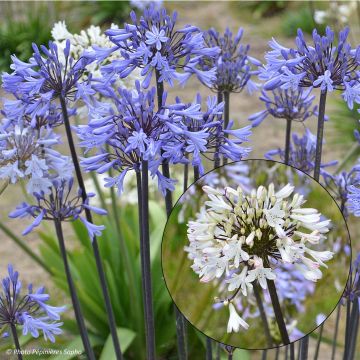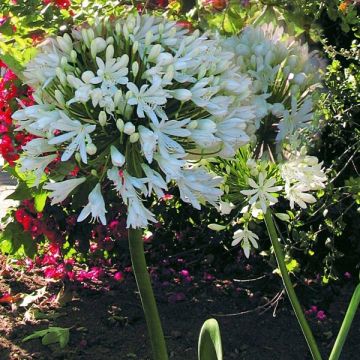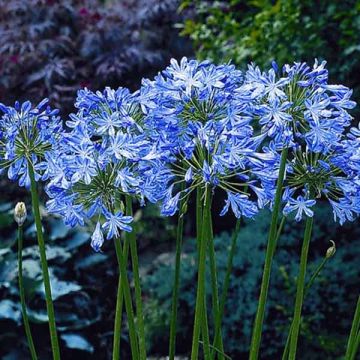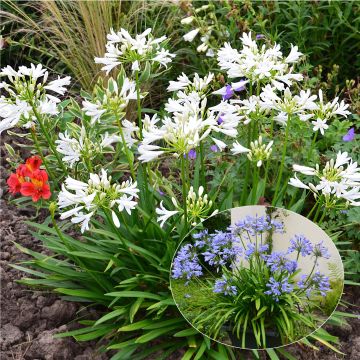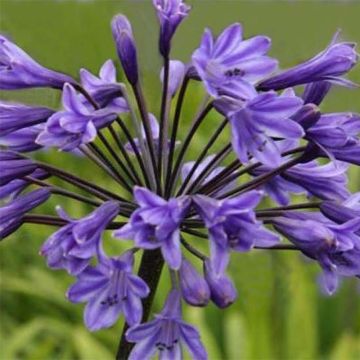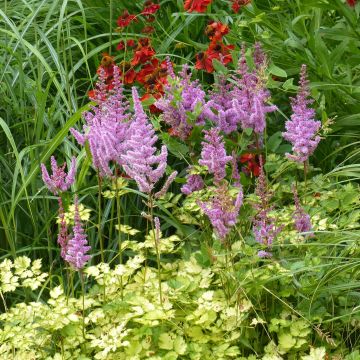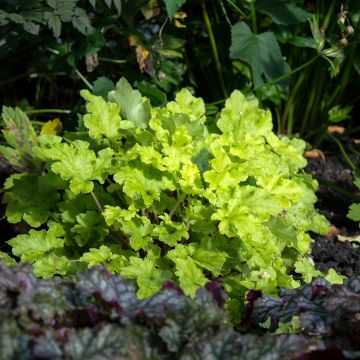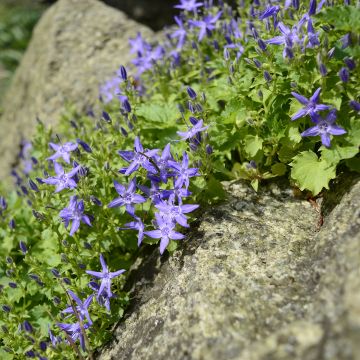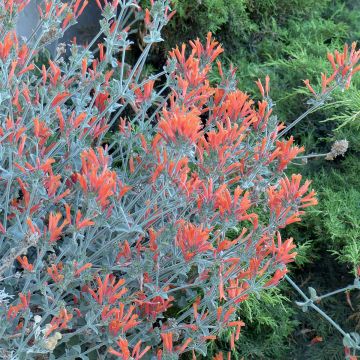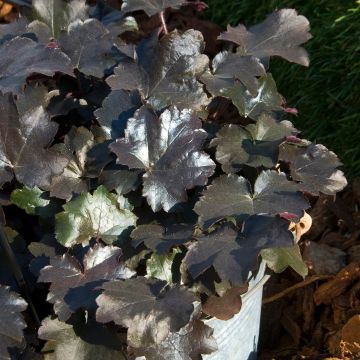

Agapanthus Blue Moon
Agapanthus Blue Moon
Agapanthus praecox subsp. orientalis Blue Moon
African Lily, Lily of the Nile
Why not try an alternative variety in stock?
View all →This plant carries a 12 months recovery warranty
More information
We guarantee the quality of our plants for a full growing cycle, and will replace at our expense any plant that fails to recover under normal climatic and planting conditions.
From €5.90 for pickup delivery and €6.90 for home delivery
Express home delivery from €8.90.
Does this plant fit my garden?
Set up your Plantfit profile →
Description
Agapanthus praecox subsp. orientalis 'Blue Moon' offers a late and quite unusual flowering: its compact umbels, carried by robust stems, bear flowers of a very pale grey-blue, a delicate colour with lunar accents that perfectly matches that of dark blue or white varieties. Its broad and ribbon-like foliage, which forms a beautiful bunch of greenery, is mostly deciduous. This variety is only moderately hardy, it will thrive on a sunny terrace, or in beds under mild climates, in well-drained soil that remains moist during the growth and flowering period.
Both originating from South Africa, Agapanthus umbellatus (or africanus) should not be confused with Agapanthus praecox, even though these two species naturally hybridize in the wild or in our gardens. Agapanthus praecox subsp orientalis is a robust plant that grows in South Africa, from the Cape Province to Natal.
The recent hybrid cultivar 'Blue Moon' develops and multiplies quite rapidly from a stump with fleshy rhizomes, forming a dense clump of linear foliage, quite wide, of a bright green, with a minimum diameter of 50cm (20in), expanding over time. Flowering generally begins in July, sometimes in August-September depending on the regions. This variety is often the last to bloom in the garden. Solid stems, 80cm (32in) to 1m (3ft) high, carry at their ends compact, hemispherical, and dense umbels where about thirty small, campanulate, very pale grey-blue flowers are tightly packed, carried by long peduncles. Agapanthus is a flowering plant capable of living up to 75 years. Its powerful roots can lift the paving of a pathway.
Agapanthus 'Blue Moon', with its late flowering in a beautiful mother-of-pearl tone that dominates a well-furnished clump, lacks elegance. It harmonizes with all the colours of the garden. It is appreciated in beds, but also in a pot on the terrace where it brings an exotic touch. Unfortunately, it is semi-hardy and disappears below -8°C (17.6°F), which is why it should be given a protected and south-facing location, and an thick mulch should be placed at its base. Whether in beds, borders, large rockeries, pots, or planters, Agapanthus is suitable for a wide variety of uses. It is particularly suitable for mild coastal climates. 'Blue Moon' is very beautiful when associated with other variegated or non-variegated varieties, with white, mauve, or dark blue flowers in a minimalist setting. It is also very decorative in beds with an exotic connotation, with Kniphofias, Hemerocallis, Crocosmias, or Tulbaghia.
Report an error about the product description
Agapanthus Blue Moon in pictures




Flowering
Foliage
Plant habit
Botanical data
Agapanthus
praecox subsp. orientalis
Blue Moon
Alliaceae - Liliaceae
African Lily, Lily of the Nile
Cultivar or hybrid
Other Agapanthus - Lily of the Nile
Planting and care
Plant the 'Blue Moon' Agapanthus stumps by covering them with at least 10cm (4in) of good soil so they are more resistant to cold. It is essential to install them in spring and mulch them in winter. For pot cultivation, use 5 young plants for a 24cm (9in) pot and shelter your pots in winter. They prefer a rich and moist but well-drained soil, enriched with sand. Water them regularly during the growth period (twice a week). However, avoid watering them afterwards. They fear excess moisture in winter. This variety particularly thrives in rockeries and containers. A sandy mixture that is rich, light and well-drained should be used. This plant seems to prefer shallow containers and will flower abundantly if regularly fed with slow-release fertilizer.
Planting period
Intended location
Care
This item has not been reviewed yet - be the first to leave a review about it.
Summer flowering perennials
Haven't found what you were looking for?
Hardiness is the lowest winter temperature a plant can endure without suffering serious damage or even dying. However, hardiness is affected by location (a sheltered area, such as a patio), protection (winter cover) and soil type (hardiness is improved by well-drained soil).

Photo Sharing Terms & Conditions
In order to encourage gardeners to interact and share their experiences, Promesse de fleurs offers various media enabling content to be uploaded onto its Site - in particular via the ‘Photo sharing’ module.
The User agrees to refrain from:
- Posting any content that is illegal, prejudicial, insulting, racist, inciteful to hatred, revisionist, contrary to public decency, that infringes on privacy or on the privacy rights of third parties, in particular the publicity rights of persons and goods, intellectual property rights, or the right to privacy.
- Submitting content on behalf of a third party;
- Impersonate the identity of a third party and/or publish any personal information about a third party;
In general, the User undertakes to refrain from any unethical behaviour.
All Content (in particular text, comments, files, images, photos, videos, creative works, etc.), which may be subject to property or intellectual property rights, image or other private rights, shall remain the property of the User, subject to the limited rights granted by the terms of the licence granted by Promesse de fleurs as stated below. Users are at liberty to publish or not to publish such Content on the Site, notably via the ‘Photo Sharing’ facility, and accept that this Content shall be made public and freely accessible, notably on the Internet.
Users further acknowledge, undertake to have ,and guarantee that they hold all necessary rights and permissions to publish such material on the Site, in particular with regard to the legislation in force pertaining to any privacy, property, intellectual property, image, or contractual rights, or rights of any other nature. By publishing such Content on the Site, Users acknowledge accepting full liability as publishers of the Content within the meaning of the law, and grant Promesse de fleurs, free of charge, an inclusive, worldwide licence for the said Content for the entire duration of its publication, including all reproduction, representation, up/downloading, displaying, performing, transmission, and storage rights.
Users also grant permission for their name to be linked to the Content and accept that this link may not always be made available.
By engaging in posting material, Users consent to their Content becoming automatically accessible on the Internet, in particular on other sites and/or blogs and/or web pages of the Promesse de fleurs site, including in particular social pages and the Promesse de fleurs catalogue.
Users may secure the removal of entrusted content free of charge by issuing a simple request via our contact form.
The flowering period indicated on our website applies to countries and regions located in USDA zone 8 (France, the United Kingdom, Ireland, the Netherlands, etc.)
It will vary according to where you live:
- In zones 9 to 10 (Italy, Spain, Greece, etc.), flowering will occur about 2 to 4 weeks earlier.
- In zones 6 to 7 (Germany, Poland, Slovenia, and lower mountainous regions), flowering will be delayed by 2 to 3 weeks.
- In zone 5 (Central Europe, Scandinavia), blooming will be delayed by 3 to 5 weeks.
In temperate climates, pruning of spring-flowering shrubs (forsythia, spireas, etc.) should be done just after flowering.
Pruning of summer-flowering shrubs (Indian Lilac, Perovskia, etc.) can be done in winter or spring.
In cold regions as well as with frost-sensitive plants, avoid pruning too early when severe frosts may still occur.
The planting period indicated on our website applies to countries and regions located in USDA zone 8 (France, United Kingdom, Ireland, Netherlands).
It will vary according to where you live:
- In Mediterranean zones (Marseille, Madrid, Milan, etc.), autumn and winter are the best planting periods.
- In continental zones (Strasbourg, Munich, Vienna, etc.), delay planting by 2 to 3 weeks in spring and bring it forward by 2 to 4 weeks in autumn.
- In mountainous regions (the Alps, Pyrenees, Carpathians, etc.), it is best to plant in late spring (May-June) or late summer (August-September).
The harvesting period indicated on our website applies to countries and regions in USDA zone 8 (France, England, Ireland, the Netherlands).
In colder areas (Scandinavia, Poland, Austria...) fruit and vegetable harvests are likely to be delayed by 3-4 weeks.
In warmer areas (Italy, Spain, Greece, etc.), harvesting will probably take place earlier, depending on weather conditions.
The sowing periods indicated on our website apply to countries and regions within USDA Zone 8 (France, UK, Ireland, Netherlands).
In colder areas (Scandinavia, Poland, Austria...), delay any outdoor sowing by 3-4 weeks, or sow under glass.
In warmer climes (Italy, Spain, Greece, etc.), bring outdoor sowing forward by a few weeks.


































